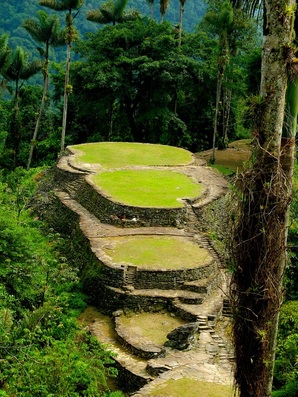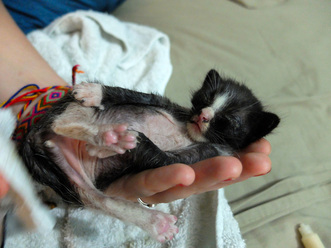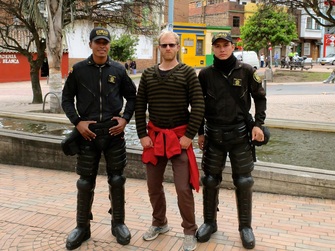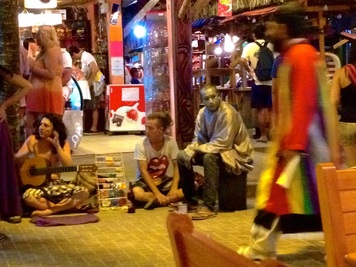 La Cuidad Perdida
La Cuidad Perdida Santa Marta & DumPster Kitty
 TINY guy
TINY guy  La Cuidad Perdida La Cuidad Perdida After our time in San Gil we were ready to head north to the Caribbean and spend some time lounging on a beach, but not before earning it. We arrived in Santa Marta early in the morning and settled into a hostel near the main market area. At first glance the city was pretty terrible: smelled of urine and rotting garbage mixed with thick black car exhaust, noisy vehicles, sketchy people, etc. I had no interest in walking around so after inquiring into “La Ciudad Perdida” (the Lost City) five-day trek through the jungle, I decided to relax and read a book for the rest of the day. Santa Marta & DumPster Kitty TINY guy TINY guy Andrew went to the bank machine and for a little walk around our area. I had expected him to take longer but after 10 or 15 minutes he barged into the room panicking, with something tucked away in his shirt. At first I thought it was a mouse or a small rat, Andrew just mumbled that he had found it screaming on a sidewalk and could barely explain that no one seemed to care and someone made fun of him for picking it up! It was a TINY kitten. Couldn’t have been more than 4 or 5 days old, with eyes still closed and one of them swollen to half the size of its head. Its hair was thick with dirt and smelled like human urine! Our hearts broke and we didn’t know what to do. Feeling like this kitten urgently needed some food, we left the hostel in search of a veterinarian. It took us far too long to find one but we eventually did after wandering through nasty smelly sweaty streets and market stands. We bought a container of kitten milk powder that you just add water to and a syringe we could use to try and feed him. We hurried back to the hostel and sterilized the syringe. Using a damp towel I cleaned the kitten as best I could while Andrew mixed some milk. It took some time to convince the kitten to eat from the syringe, but with patience we got the job done.
4 Comments
After defeating Greece 3-0 and a closer win over the Ivory Coast at 2-1, Colombia gears up today to play Japan. In Colombia, “gearing up” means…
Loving Colombia so far! We arrived in Bogotá after a 16 hour journey, flying from Buenos Aires through Lima (and staying overnight in the airport). We landed fairly early in the day and were settled into Hostel Sue Candeleria in the La Candelaria district (the more touristy and unfortunately more sketchy area). It was federal election day and the day after Colombia's first World Cup win (and subsequent celebratory rioting) so Bogotá was a bit rowdy. We asked a couple of military guys at the airport if it was safe to hang out in Bogotá during the election and how things were going, and they just said “todo tranquilo, hay muchas policías en las calles, esta muy seguro” (everything is good, there are many police in the streets, it is very safe) – that sounded pretty good so we decided to go for a little walk around.  Bogotá police in their skateboarding gear Bogotá police in their skateboarding gear We intended to try and get to Plaza Bolívar (the main square) but never made it that far because the police had put up barricades, likely to stop people from gathering in crowds. We just wandered around La Museo de Oro (the Gold Museum) listening to the street music, watching the vendors selling all kinds of delicious fried or sugar-coated snacks and, of course, giving trying some of them a try. I had a version of the delicious Alfajor from Argentina (Argentina's version is a bazillion times better) – this one was just some plain crispy wafers with a bunch of dulce de leche (thick caramel sauce) in between, mmmmm. I had eaten most of it but had maybe three or four bites left when a happy looking (possibly homeless) guy asked me for some money. Instead, I gave him the rest and he happily thanked me and wandered away, dancing and singing. Things seemed OK in the streets; there were several police and military people just hanging around and patrolling everywhere, with their massive guns at their sides. While some people may find that comforting, I found it unnerving.
 a beautifully deadly turn a beautifully deadly turn La Paz sucks.
Keep in mind here that neither Chelsea nor I are big fans of cities - they're usually too busy, too noisy, too smelly... we'd both really rather be in a smaller town or out lost in the wilderness. La Paz, Bolivia's bustling administrative capital, is the epitome of all that sucks about cities: streets packed with breaking-down cars and trucks, all constantly weaving around one another, doing their best to decorate their hoods with pedestrian guts while spewing plumes of acrid, black exhaust; sidewalks and plazas crammed with crowds of pushy, loud strangers all pushing their way past the rancid cesspools of garbage and human waste that scatter the streets. I'm sure there are some worthwhile spots hidden within the nightmarish cityscape, though we were so appalled we did our best to stay hidden in our hostel. One of the few times we did venture out in search of a decent meal, we discovered a maggot at the bottom of our (otherwise delicious) compost soup. Okay, fine, the central market was a great place to stock up on alpaca-wool sweaters in preparation for the coming cold of Patagonia, and the Witches' Market was a perfect spot to shop around for stuffed piranhas and llama fetuses. Alright, I'll admit that there were a couple okay watering holes, some even offering different options (options!) of beer: our aptly-named hostel Adventure Brew even had a decent micro-brewed IPA, the likes of which my lips hadn't touched since leaving Canada. On the whole, however, La Paz sucks. Unfortunately, however, traveling around Bolivia by bus will almost inevitably leave you stuck there for a night. For us, the only redeeming feature of La Paz was its proximity to "Death Road", the site of numerous fatal vehicle accidents (including a single event in the 80's which took the lives of over one hundred people) and a popular spot for downhill mountain biking.  Montañita, Ecuador - lots of interesting people Montañita, Ecuador - lots of interesting people It started out as a very high fever. I thought I was going to freeze to death but the thermometer said I was nearly 104°F. In the middle of the night on day two of the fever we went to the hospital. There were two nurses telling jokes to each other in the corner who were visibly annoyed that we showed up. They woke up the pharmacist who took some blood, told us that I didn’t have dengue and sent us home. No investigation into what it would have been. Just told us to go away. Later we found out that you can’t test positive for Dengue until after 6 days of fever. The next day I went to a different pharmacist down the street from our hostel and asked for antibiotics because I thought maybe I had an infection or something. They gave them to me without question or explanation of any side effects or anything. I later found out that you can get as much of anything you want from any pharmacy here – for example a guy from our Spanish classes bought 20 or more vicodin, valium, oxycotin and some other mystery drugs that are apparently stronger than all of those. He bought them all at once and took most of them in one day. Apparently this is one reason that a lot of people come to Montañita. The doctor recommended that I return for monitoring in a few days, however when we did return, no one there could find any record of me ever being there so after A LOT of persuasion we got them to run some new tests that we took with us and emailed to our health insurance providers in Canada. Luckily google gave us the heads up on my symptoms and nothing suggested the dangerous type of dengue (the one where you haemorrhage and your insides turn to mush) so I just had to wait it out. After 12 days of fever between 101-104°F I finally awoke without a fever. For the next three days I had random full body hive flare-ups which google alerted us was normal for the recovery stage of Dengue. It took another few days before I was able to eat a full meal again and about two weeks before the nausea finally left (now).  Unfortunately my opinion of Montañita is not too good, likely in part based on the fact that I felt like crap the whole time we were there. However I did manage to attend 20 hours of Spanish lessons at Montañita Spanish School, which were very good, and we did a couple of smaller day excursions as well. I just had to get out of the hostel we were staying in.  Shnoopy - one of the sick dogs in Santa Catalina Shnoopy - one of the sick dogs in Santa Catalina Hola Amigos,
After a few months of travelling in Central America, I want to share with you some of the things that we didn't like. While we have found much beauty and met several wonderful people along the way, not everything is wonderful all of the time. I can't speak accurately for Andrew though I know that he is having a little difficulty dealing with not having a "goal" or "mission" to work toward. For me it is a little bit different. I don't miss "home" exactly, but the constantly packing and unpacking is a little bit tiring, and I am getting sick of my clothes. Always the same outfits that I don't really like anymore, lol, and always having to decide which outfit is less dirty to wear that day. It feels like we are constantly doing laundry! This doesn't bother me THAT much, but along with a few other things, makes some days feel very exhausting. What has been getting to me more lately are the negative looks from people in places that we go. It is not the majority of people by any means, but those few and far between people who clearly do not appreciate our presence in their town and who believe that we are somehow the cause of all of their pain and suffering. I try not to let it get to me, but I have to admit that it does make me feel guilty. Guilty that I have enough money that I can go travelling for a year and not have to worry about starving to death on any given day. Guilty that if I don't like it here, I can just go somewhere else. This combined with the majority of people who are constantly trying to overcharge us because they believe that we are some sort of money machine and don't actually care at all to know who we are. Often times they go out of their way to make sure that we feel guilty if we don't buy something from them. It really is unfair that we can live our lives this way, and most people in the world will never have this opportunity. It is shameful that corruption, greed and politics get in the way of government and allow this to go on in this day and age. |